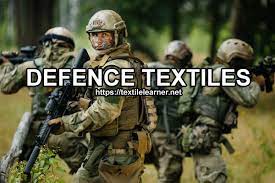A vital part of defense technology, military fabric is essential to maintaining the effectiveness, comfort, and safety of the armed forces in a variety of operational situations. Modern military gear has been greatly influenced by the incorporation of cutting-edge textiles and materials over the years. This article examines the importance of military fabric, its variety, technological developments, aerospace and defense applications, obstacles encountered, and the outlook going forward.
Types of Textiles Used in Military
1) Ballistic Fabrics: Ballistic textiles are among the best kinds of military textiles because of their strong resistance to impact and projectiles. By utilizing cutting-edge fibers like Dyneema and Kevlar, these materials provide military troops with unmatched protection against ballistic threats in battle zones.
2) Flame-Resistant Fabrics : Flame-resistant textiles act as a barrier of defense in harsh environments where there is a high risk of fire. These fabrics, which are engineered with certain fibers and treatments, provide durability against fires and lower the possibility of severe burns in situations of crisis.
3) Camouflage Textiles: In military operations, hiding offers a significant strategic advantage. In order to ensure that soldiers, vehicles, and equipment blend in smoothly with their surroundings, avoiding detection and boosting tactical dominance, camouflage fabrics make use of creative patterns and materials.
Innovations in Military Textile Tech
1) Nanotechnology Advancements: The fabric used in military gear has gradually been infused with nanotechnology in recent years, giving it improved functionalities and capabilities that were previously impossible with traditional materials. The engineering of matter at the nanoscale, or in the range of 1 and 100 nanometers, has resulted in a new era of textiles that are strong, lightweight, and have multiple uses. Materials have specific characteristics at the nanoscale because of their increased surface area and changed chemical, physical, and biological properties. Overcoming obstacles including resilience to harsh temperatures, durability, and adaptation to a variety of settings is necessary to meet the unique needs of military fabric. Additionally, cutting-edge capabilities like self-healing and adaptability must be included.
2) Smart Textiles and Their Functions:
Smart Textiles:
By combining cutting-edge technology with conventional textiles, smart textiles—also referred to as e-textiles or smart fabrics—have completely transformed the world of textiles and provide a vast range of uses beyond simple apparel. They represent a fascinating mix of technology and textiles, fulfilling functions that go much beyond those of traditional materials. Let’s dive deeper into the marvels and functionalities of these ingenious fabrics.
Smart Textiles Functions:
Health-monitoring Textiles: These innovative textiles include sensors to track key indicators like body temperature and heart rate, as well as identify any health problems. They are transforming healthcare by providing a continuous, safe monitoring system.
Temperature-regulating Textiles: Phase-change materials or conductive components are used in smart textiles to control body temperature. Because of their ability to adjust to environmental changes, these textiles offer comfort in any kind of weather environment.
Conductive Textiles: Through the use of conductive fibers to transport electricity, conductive textiles open up new possibilities in wearable technology by enabling features like electronic circuits, heating components, and touch-sensitive controls.
Responsive Textiles: These fabrics react quickly to external forces, changing their characteristics as the light, temperature, or other surroundings change. Their ability to alter color, form, or texture increases the adaptability of design and functionality.
Applications of Textiles in Defense
1) Body Armor and Protective Gear: The basic component of body armor is military cloth, which shields soldiers from physical threats and minimizes the impact of injuries. Furthermore, specialist materials are used in the construction of protective gear such as gloves and helmets to guarantee maximum safety.
2) Tenting and Shelters: Textiles are essential in field operations for building informal tents and shelters that provide protection from bad weather. Solid and weather-resistant materials help to build sites that are safe for soldiers.
3) Military Uniforms and Apparel: Modern textiles play a major role in military uniform usefulness and design. These textiles are designed to meet the various demands of soldiers in a range of environments and climates by offering comfort, toughness, protection, and camouflage.
Challenges and Future of Military Fabric
1) Sustainability Efforts: The military fabric industry is investigating environmentally appropriate substitutes and production techniques to reduce environmental effect without sacrificing performance as their focus on sustainable growth opens the door for more sustainable and environmentally friendly textiles.
2) Emerging Trends and Future Developments: There is a lot of exciting progress ahead for military textiles in the future. Self-adjusting fabrics, improved biodegradability, and more use of smart technology will be future advancements that will revolutionize defensive plans globally.
Conclusion
The defense technology field has seen major changes with the evolution of military fabric, guaranteeing the safety, effectiveness, and adaptability of armed forces. Future developments point to even more advanced textiles that support defense capabilities and are in line with sustainable norms, provided there is a sustained focus on addressing difficulties and continuing innovation.
Writer’s Information_
Akhi Akter
B.Sc in Textile Engineering
Green University of Bangladesh (GUB)


